War bonsai trees, like the resilient Yamaki Pine from Hiroshima, are historically significant because they embody survival and resilience. They’re not just plants; they are living legends that tell stories through their twisted trunks and lush needles. Can you envision a tree that’s weathered bombs? These bonsai symbolize peace and goodwill, serving as ambassadors of cultures. Isn’t that fascinating? Stick around, and I’ll share more about how bonsai culture evolved through history and connects us all!
Quick Takeaways
- War bonsai trees, like the Yamaki Pine, symbolize resilience and survival amidst destruction, representing hope and endurance in the face of tragedy.
- They serve as diplomatic gifts, embodying peace and goodwill, while fostering cultural respect and understanding between nations, particularly post-WWII.
- The historical significance of war bonsai lies in their narrative, connecting generations and transcending cultural boundaries through shared experiences of conflict and recovery.
- Post-war, bonsai transformed in Western culture, becoming a symbol of artistry, resilience, and the fusion of diverse cultural perspectives.
- War bonsai trees reflect a broader cultural heritage of resilience, preserving identity and continuity through challenging and transformative historical events.
The Resilient Pine of Hiroshima: A Living Symbol of Survival
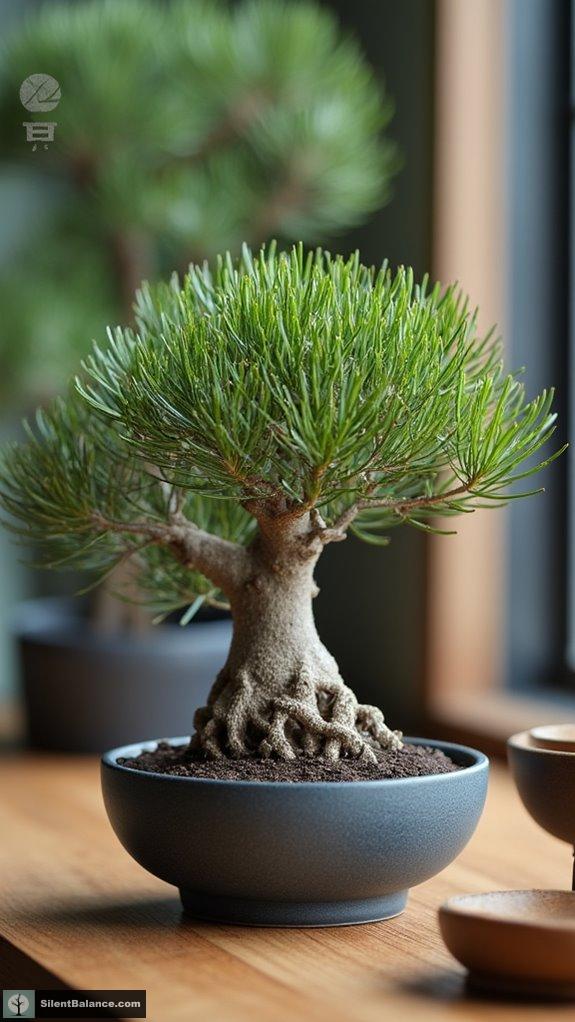
When it comes to the storied history of bonsai trees, you can’t help but feel a twinge of awe at the tale of the Yamaki Pine.
This remarkable Japanese white pine, standing two feet tall, has withstood the maelstrom of Hiroshima’s atomic fury, shielded by its sturdy wall.
It’s like nature’s ultimate survivalist, right?
With over 400 years of cultivation by the Yamaki family, it embodies resilience and artistry.
Imagine it, a green and yellow needle-clad masterpiece, whispering tales of endurance through generations.
Interestingly, this bonsai was donated to the museum in 1976 by bonsai expert Masaru Yamaki, symbolizing friendship between two cultures.
Isn’t it incredible how this tree symbolizes peace, transcending tragedy and connecting cultures?
Kyūzō Murata’s Nighttime Vigil: The Protector of Imperial Bonsai

In a world where every leaf and branch tells a story, Kyūzō Murata has carved his own legendary tale as the guardian of Japan’s Imperial Bonsai Collection.
Picture him, dedicated and vigilant, patrolling at night—who does that for trees? His all-consuming passion guaranteed these national treasures survived countless threats, from pests to decay.
With decades under his belt, you’ve got to admire that commitment to bonsai as living art.
Decades of dedication reflect an unwavering love for bonsai, celebrating it as a true living art form.
His efforts symbolize a deep connection between caretaker and creation, quite poetic, right?
In preserving these beauties, Murata didn’t just protect trees; he safeguarded Japan’s spirit, elevating bonsai culture to new heights.
The Legacy of Peace: Bonsai as Gifts of Goodwill
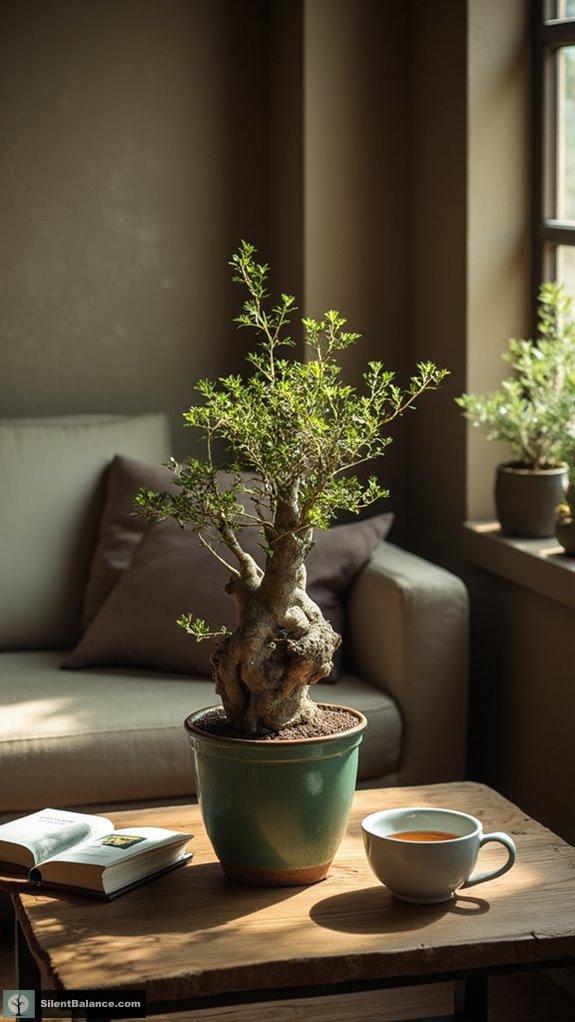
Bonsai trees aren’t just pretty little plants; they’re living symbols of peace and goodwill exchanged across continents, often steeped in rich history.
Consider the 400-year-old Yamaki pine—the ultimate peace offering from Japan to the U.S., celebrating resilience after Hiroshima.
These beautifully sculpted trees aren’t just horticultural showpieces; they’re diplomatic ambassadors that transcend history and conflict.
When a bonsai is gifted, it carries deep narratives of friendship, reconciliation, and cultural respect.
Isn’t it remarkable how a tiny tree can connect nations?
Next time you admire a bonsai, take note—it’s not just a plant; it’s a legacy of peace.
Omiya Bonsai Village: A Center of Cultural Resilience
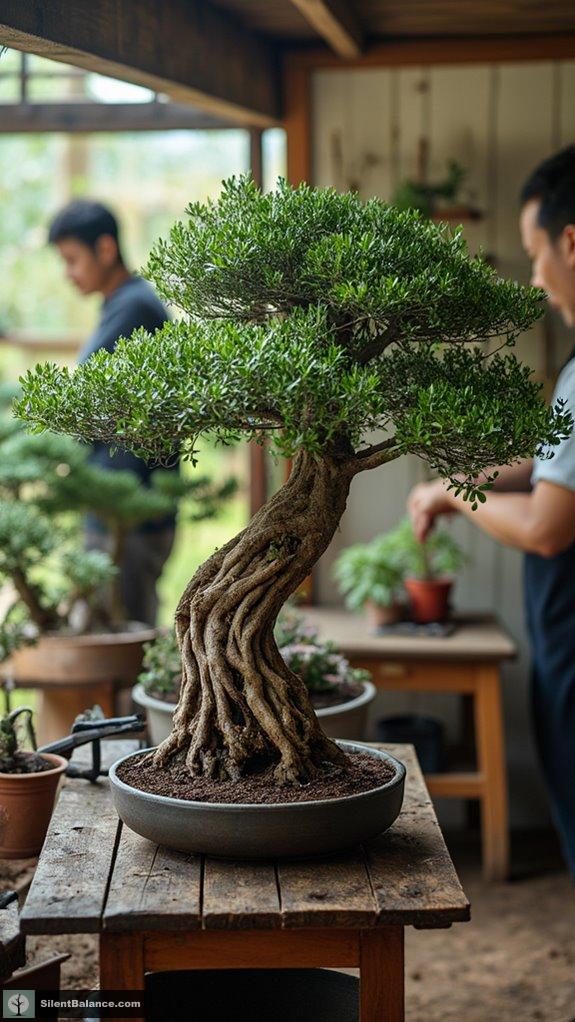
Nestled just outside of Saitama City lies Omiya Bonsai Village, where history, artistry, and culture intertwine like the delicate roots of a meticulously cultivated tree.
Founded in 1925, this vibrant community showcases the dedication and resilience of bonsai artisans—people whose passion for miniature trees survived even the darkest times.
Ever heard of Bonsaicho? That’s what the locals coined this cultural haven.
With over 30 nurseries springing up from traditional roots, Omiya became the go-to spot for bonsai enthusiasts.
Cultural Commemoration Through War Bonsai Exhibitions
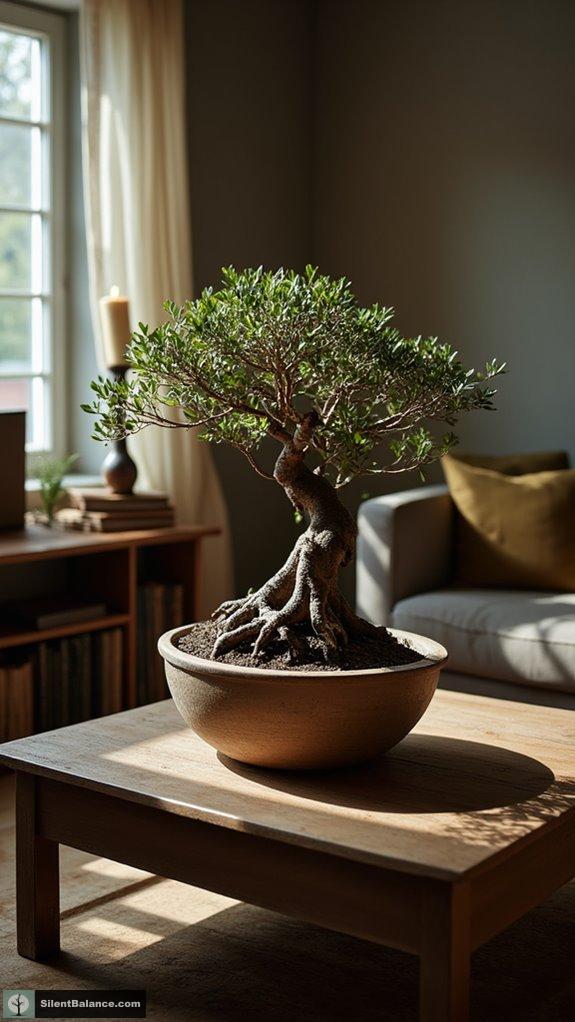
While delving into the complex world of war bonsai exhibitions, you’ll discover something truly remarkable: these events go far beyond showcasing beautiful trees. They weave narratives of resilience, cultural dignity, and hope planted deep within their roots.
| Aspect | Significance | Example |
|---|---|---|
| Historical Trauma | Reflects personal suffering | “World War Bonsai: Remembrance” |
| Cultural Identity | Asserts heritage under oppression | Artists’ defiance during internment |
| Peace & Reconciliation | Bridges painful histories | International bonsai collections |
| Community Healing | Fosters awareness of racial equity | Programs encouraging dialogue |
The Transformation of Cultural Perception Post-WWII
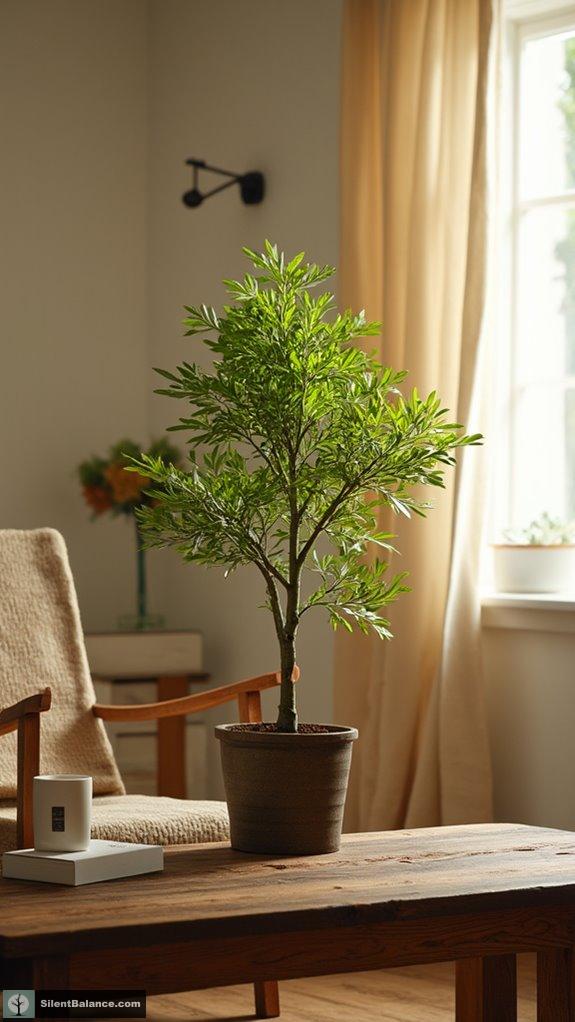
After WWII, a fascinating transformation took root in the world of bonsai, forever altering its cultural perception.
Imagine American soldiers, dusty boots in Japan, discovering the serene beauty of bonsai for the first time. They didn’t just bring back souvenirs; they introduced an entire art form, igniting curiosity across the West.
Bonsai exhibitions blossomed, morphing into educational platforms, and turning the once-insular practice into a global phenomenon.
As the artistry evolved, bonsai transcended mere craft. It became a symbol of resilience, peace, and cultural fusion.
Isn’t it incredible how a tiny tree can carry such monumental weight in our global narrative?
Connecting Generations: War Bonsai and Historical Narratives
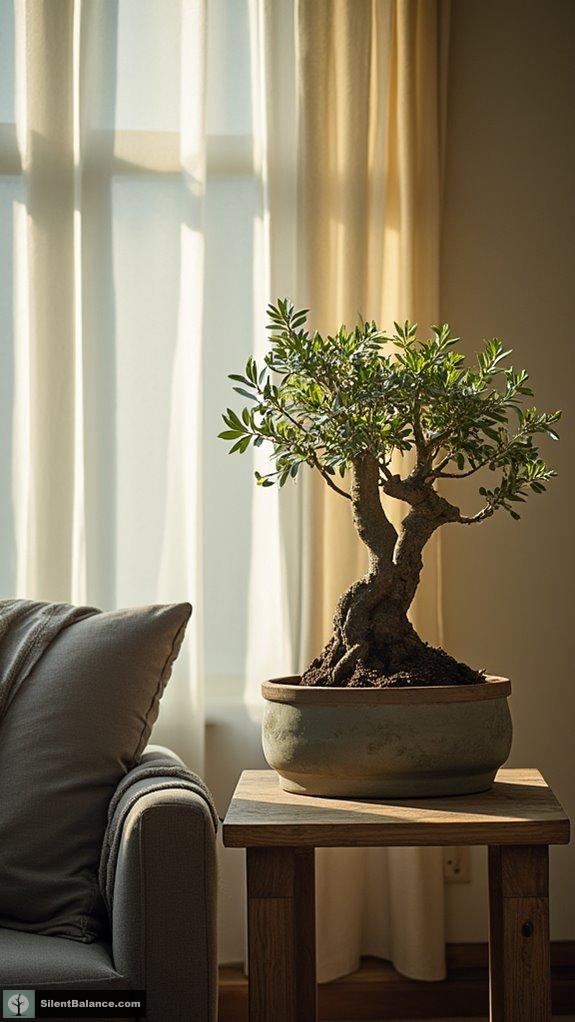
Connecting generations through the ancient art of bonsai isn’t just about cultivating trees; it’s about nurturing stories that intertwine with history itself.
Have you ever marveled at a 400-year-old Yamaki bonsai, surviving Hiroshima’s wrath? It’s not merely a plant, but a living symbol of resilience, link to its caretakers spanning centuries.
A 400-year-old Yamaki bonsai stands as a testament to resilience, weaving together centuries of history and survival.
Bonsai cultivation, often labeled as an art, symbolizes peace and reconciliation, reinforcing bonds that transcend conflict.
As we prune and shape these complex wonder-trees, we don’t just sculpt foliage; we carve out narratives of survival and identity.
The Evolution of Bonsai Techniques During Wartime Recovery
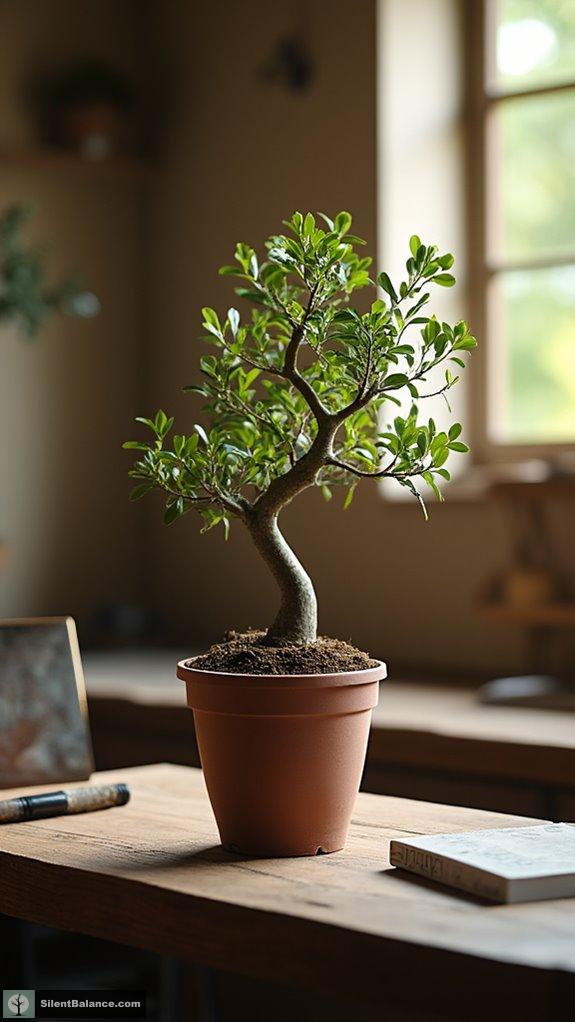
As we immerse ourselves in the evolution of bonsai techniques during wartime recovery, it’s fascinating to see how adversity spurred innovation in this cherished art form.
Picture this: post-war artisans, faced with scarcity, transformed younger plants into masterpieces.
They dived deep into plant physiology, refining pruning and grafting techniques.
Ever heard of saikei? This tray environment technique broadened artistic horizons, moving bonsai beyond rigid forms.
It’s amusing how challenges led bonsai to embrace elegance and wild aesthetics, reflecting Zen ideals.
Cultural Heritage of Resilience

Did you know that bonsai trees aren’t just about little plants in pots? They embody a cultural heritage of resilience, thrumming with history and strength.
Consider these compelling points:
Consider the rich tapestry of bonsai’s history and its powerful symbolism of resilience and cultural continuity.
- Some survived the Hiroshima bombing, defying destruction.
- They symbolize the continuity of peace and cultural preservation.
- Practitioners, even post-World War II, expanded bonsai’s reach beyond Japan.
- Bonsai serves as a living symbol of national recovery.
- These trees not only endure trauma but foster global respect and understanding.
- Additionally, bonsai reflects the spiritual significance that transcends cultures, showcasing the deep connection between nature and human experience.
Questions and Answers
What Specific Techniques Evolved in Bonsai Cultivation During Wartime Recovery?
Oh, the irony! As bombs fell, bonsai styles blossomed.
During post-war recovery, we saw the rise of copper wire, which replaced iron, allowing for greater artistry in tree shaping.
Pruning became precise, thanks to the fancy steel tools that emerged, catering to our newfound obsession with detail.
And let’s not forget—limited plant varieties sparked innovative techniques that transformed bonsai into a dazzling art form.
Who knew scarcity could fuel such creativity, right?
How Did the Symbolism of Bonsai Change Post-Wwii?
Post-WWII, bonsai transformed from a purely Japanese icon to a global symbol of resilience and peace.
Envision a 400-year-old tree, surviving the Hiroshima blast—can you picture its quiet strength?
As American soldiers and Japanese-Americans shared this art, bonsai came to represent healing, bridging cultural divides.
It wasn’t just about aesthetics; it became a proof of survival and friendship.
Isn’t it fascinating how a tiny tree can hold such monumental significance?
What Species of Bonsai Were Most Affected by Wartime Shortages?
Ah, bonsai—tiny trees with monumental stories!
During wartime, dwarf pines and plums faced steep challenges.
With collectors losing prized specimens to bombings, we saw a shift. White pines, like the resilient Hiroshima survivor, became symbols of hope.
Honestly, who knew copper wire would replace iron due to metal shortages? Talk about a twist in bonsai history!
How Did International Interest in Bonsai Influence Japanese Practices?
International interest in bonsai has really transformed Japanese practices, and let’s be honest, it’s been a game-changer.
When Western enthusiasts fell head over heels for these miniature marvels, it pushed Japanese bonsai masters to innovate, blending traditional techniques with fresh ideas.
This fusion sparked creativity, making bonsai not just an art form but a lifestyle.
Isn’t it fascinating how a tiny tree can bridge cultures and inspire worldwide?
That’s the beauty of bonsai, isn’t it?
In What Ways Do Bonsai Serve as Educational Tools Today?
You ever considered how bonsai can be more than just a picturesque plant?
These miniature masterpieces teach us patience and precision. They’re all about the art of horticulture—pruning, wiring, and coaxing life from a tiny pot.
With hands-on workshops and informative classes, bonsai cultures bridge gaps, leading us to reflect on resilience and beauty. It’s like constant self-improvement wrapped in leaves!
Who knew tiny trees could pack such a powerful educational punch?
References
- https://en.wikipedia.org/wiki/History_of_bonsai
- https://boundarystones.weta.org/2025/05/19/hiroshima-washington-beloved-bonsais-journey-war-peace
- https://www.kuow.org/stories/bonsai-tree-exhibit-offers-novel-take-on-75th-anniversary-of-end-of-world-war-ii
- https://hookedonbonsai.com/bonsai-tree-origin/
- https://www.bonsaiempire.com/origin/bonsai-history
- https://www.mistralbonsai.com/en/the-bonsai-that-survived-hiroshima/
- https://www.smithsonianmag.com/history/390-year-old-tree-survived-bombing-hiroshima-180956157/
- https://www.bonsai-nbf.org/yamaki-pine
- https://www.bonsaiempire.com/blog/hiroshima-survivor
- https://www.librarything.com/author/muratakyuzo
- Bonsai Placement Benefits for Room Harmony - November 8, 2025
- Why Use Air Layering to Propagate Bonsai Trees? - November 8, 2025
- 15 Stunning Acorn Wood Wall Art Ideas - November 8, 2025

